Download Printable Brussels Sprouts Growing Guide »
Whenever someone asks me my favorite veggie to grow in the garden, the answer is always the same—my beloved Brussels sprouts! Brussels sprouts grown in the garden are packed with tons of flavor (they taste like a whole different veggie from the grocery store version), they are hardy enough to handle freezes and frosts, and they are a breeze to grow!
If you’ve been intimidated by growing Brussels sprouts in the past, let us show you just how simple it is to add this tasty vegetable to your garden! Let’s get growing.
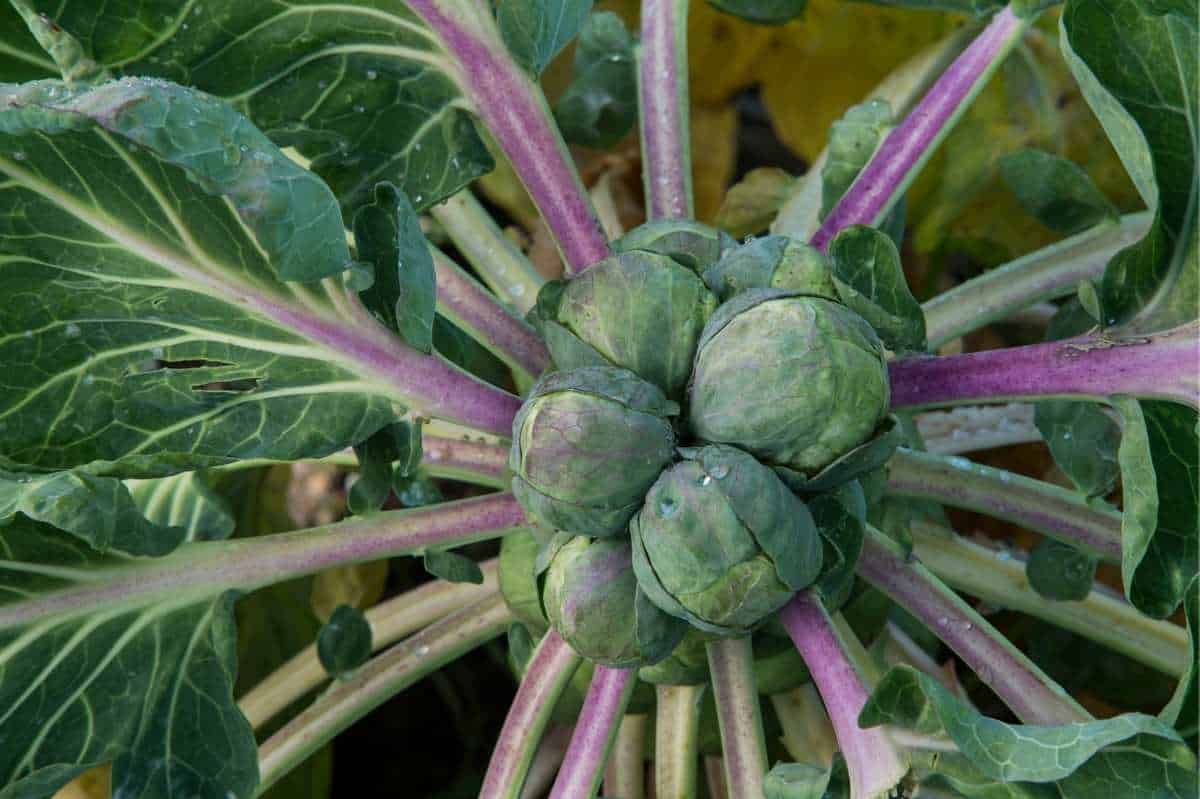
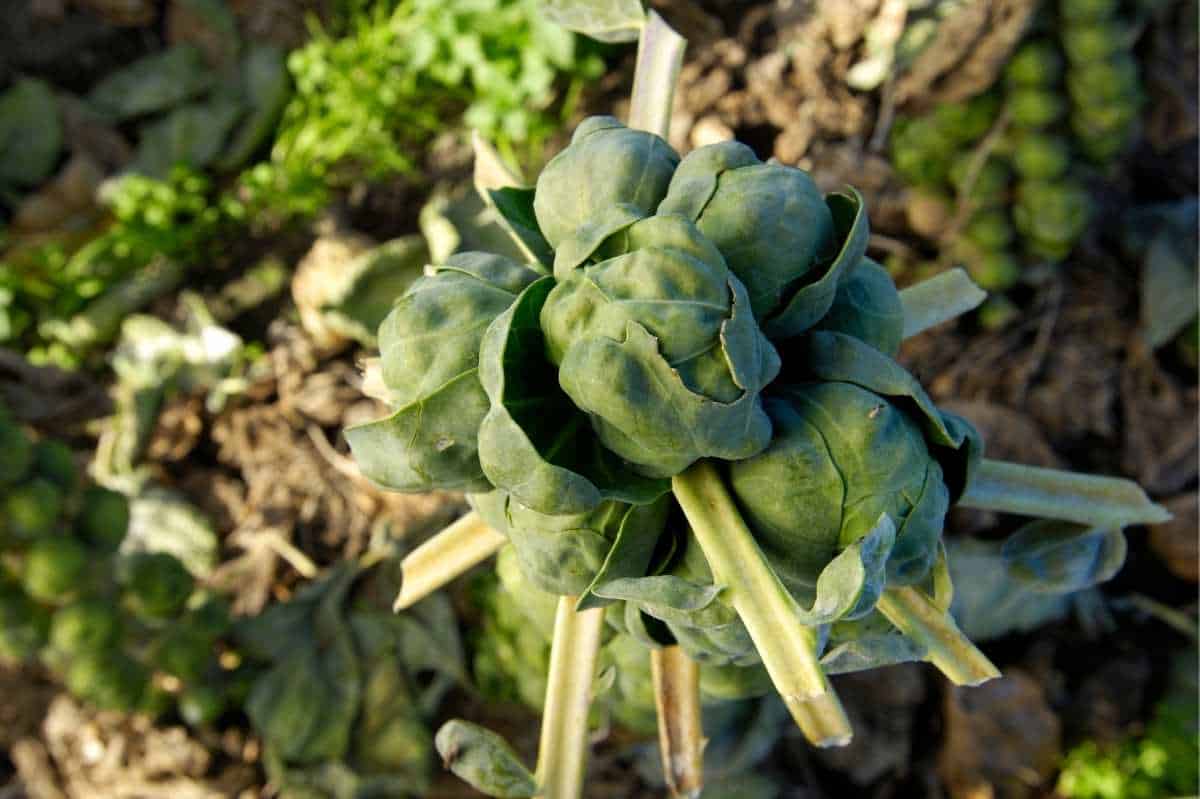
Table of Contents
Are Brussels sprouts easy to grow?
Because of their large size, a lot of folks think sprouts are intimidating to grow, but they actually require almost no care once they’ve been planted in the ground. These easy-to-grow plants need quite a long period of cool weather to produce. So just as long as you have the space and the right period of cool weather, they’re a breeze!
Where do I plant my Brussels sprouts?
Brussels sprout plants are very large—spanning about 18-36″ tall with a spread width of at least 18″. Their large size makes these plants perfect candidates for in-ground or raised bed planting.
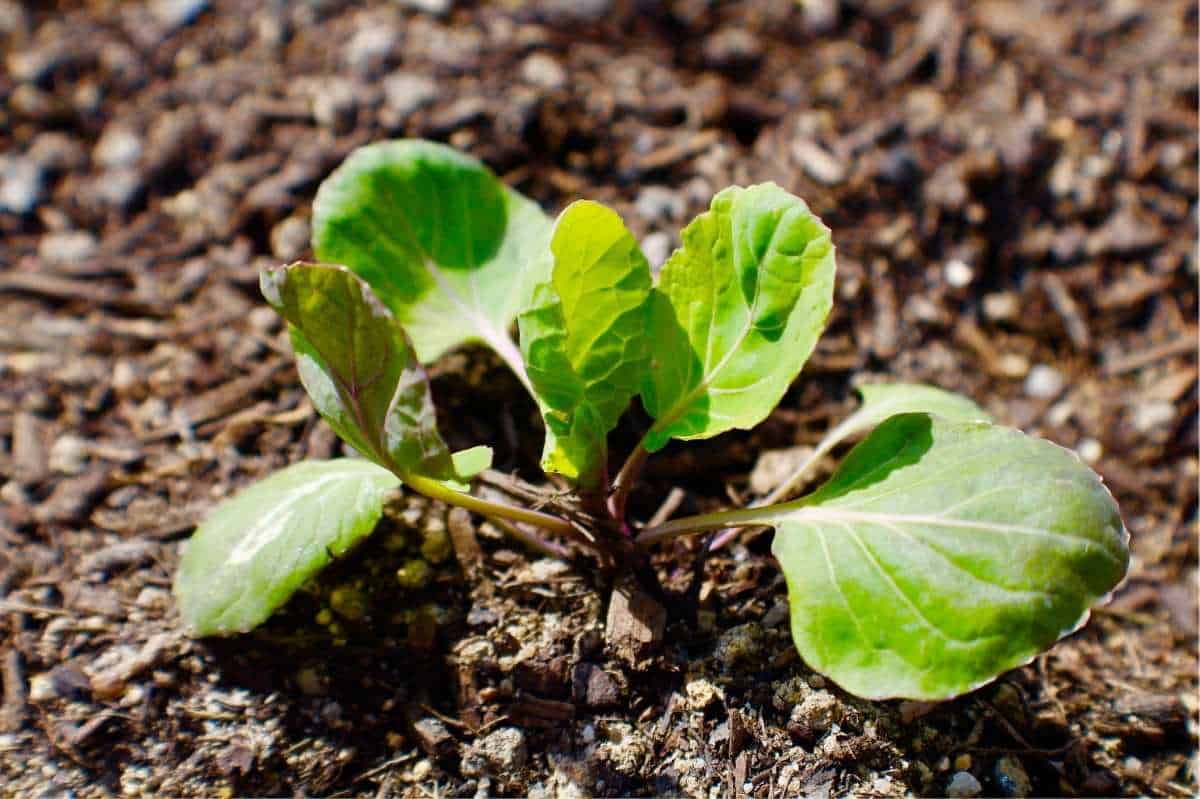
Should I grow Brussels sprouts from seeds or plants?
We’re a big advocate of growing from seed here at Growfully because you have such a wider variety of Brussels sprouts (Brassica oleracea) seeds to choose from (purple Rubine sprouts, yes, please!). But seedlings also work if you can track them down. Brussels sprouts are typically best as a fall crop, and tracking down the seedlings at your local garden center in the middle of summer or early fall can be tricky.

When should I plant Brussels sprouts?
In most regions, Brussels sprouts are a summer-planted crop for fall harvest—that’s just the best way to give Brussels sprouts the long, cool season they require. If you live in a mild climate that doesn’t have hot summers, you can also plant a spring crop of Brussels sprouts. Just keep in mind, you need to keep your Brussels sprouts plants growing in mild or cool temperatures for 100-200 days (depending on the variety).
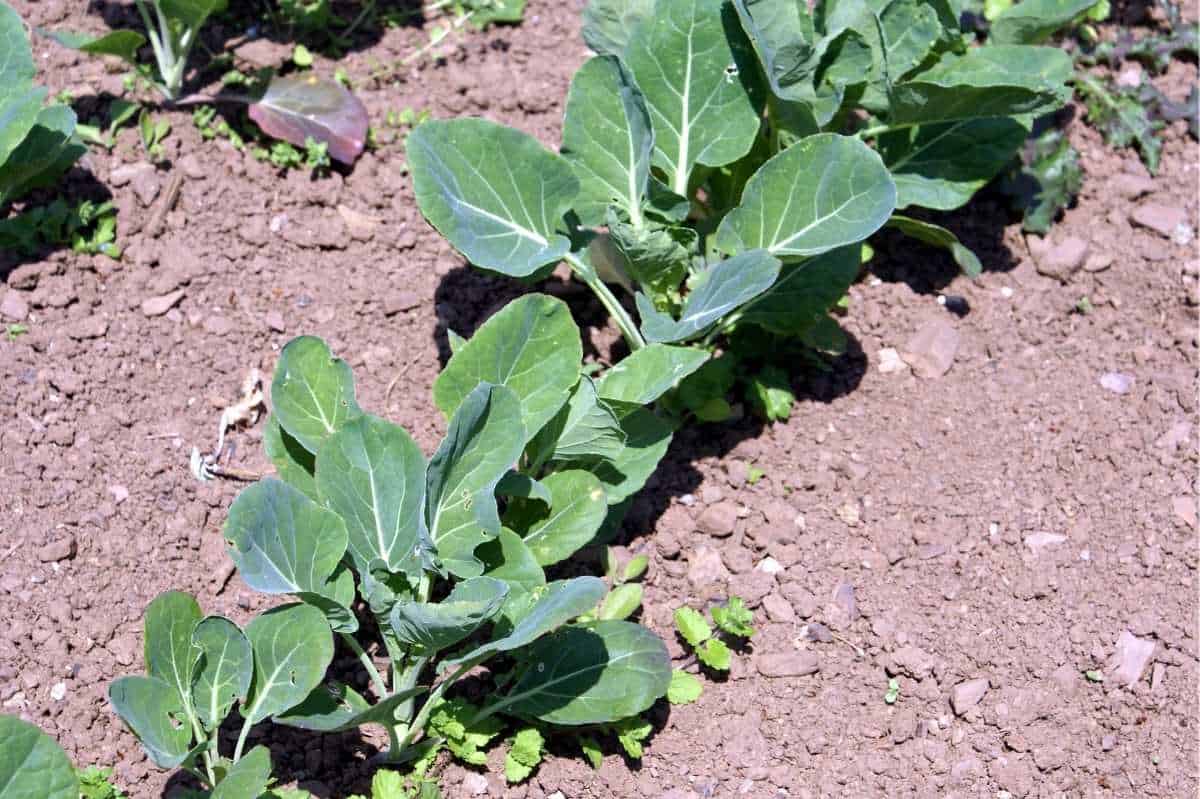
To figure out your own planting date, take the date of your average first frost in fall, and subtract 10 weeks—that’s around the time you want to plant the seedlings in the garden. From that date, subtract 6-8 weeks (depending on the variety)—that’s the date to start your seedlings.
Growfully Protip
Here in zone 6b, we typically start our Brussels sprout seeds indoors early-to-mid June and then plant them out on a cool day in the garden in August. It’s still hot in August, but the temps will quickly start to decline a few weeks later.
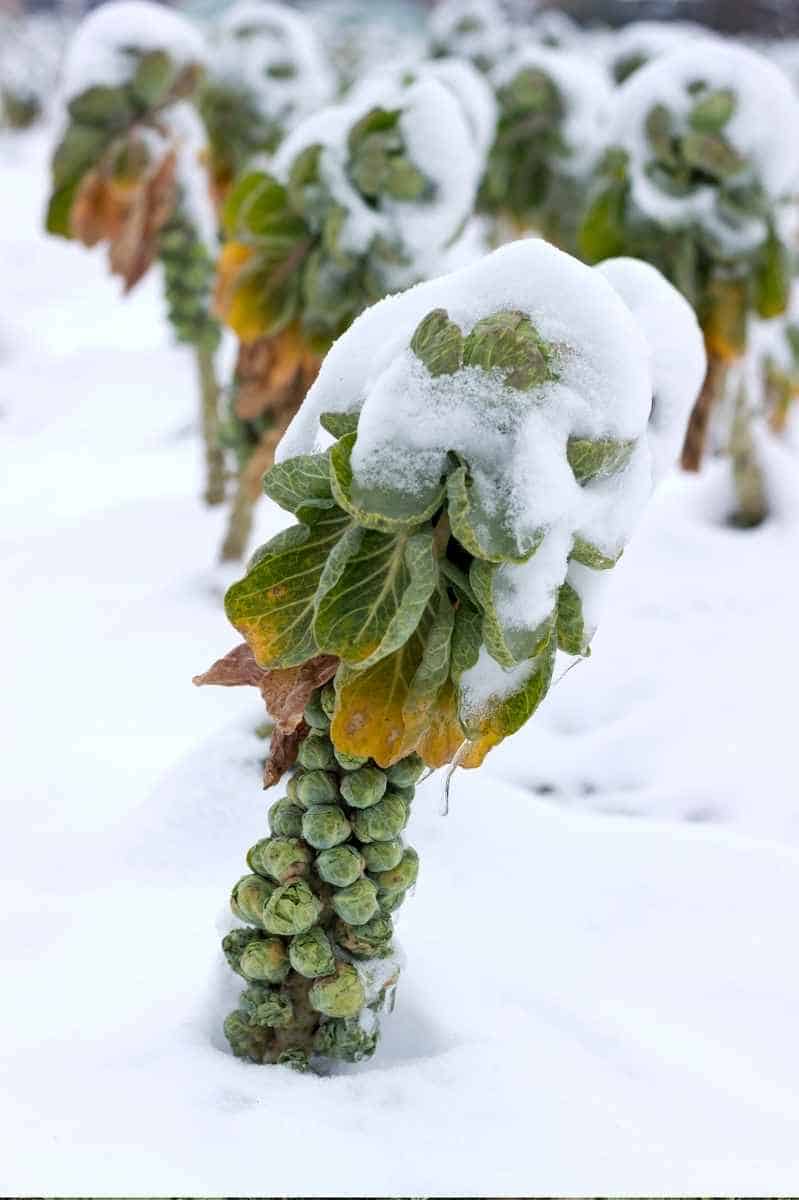
How long does it take to grow Brussels sprouts?
All Brussels sprouts varieties are slow-growing plants. Even the quickest of Brussels sprouts will take at least 100 days to get to maturity, with some going as long as 200 days. Don’t fret, though! You can use this wide disparity between maturity dates to your advantage. Plant at least three different varieties with different maturity dates, and harvest Brussels sprouts all fall and winter long!
How do I grow Brussels sprouts from seed?
Brussels sprouts are a brassica, and you follow the same process for seed starting as with other brassicas like cabbage, broccoli, kale, or cauliflower. In cool, mild climates, you can start seeds directly in the garden. For those of us with hot summers, you’ll need to start seeds inside to protect them from the hottest part of the year. To start seeds:
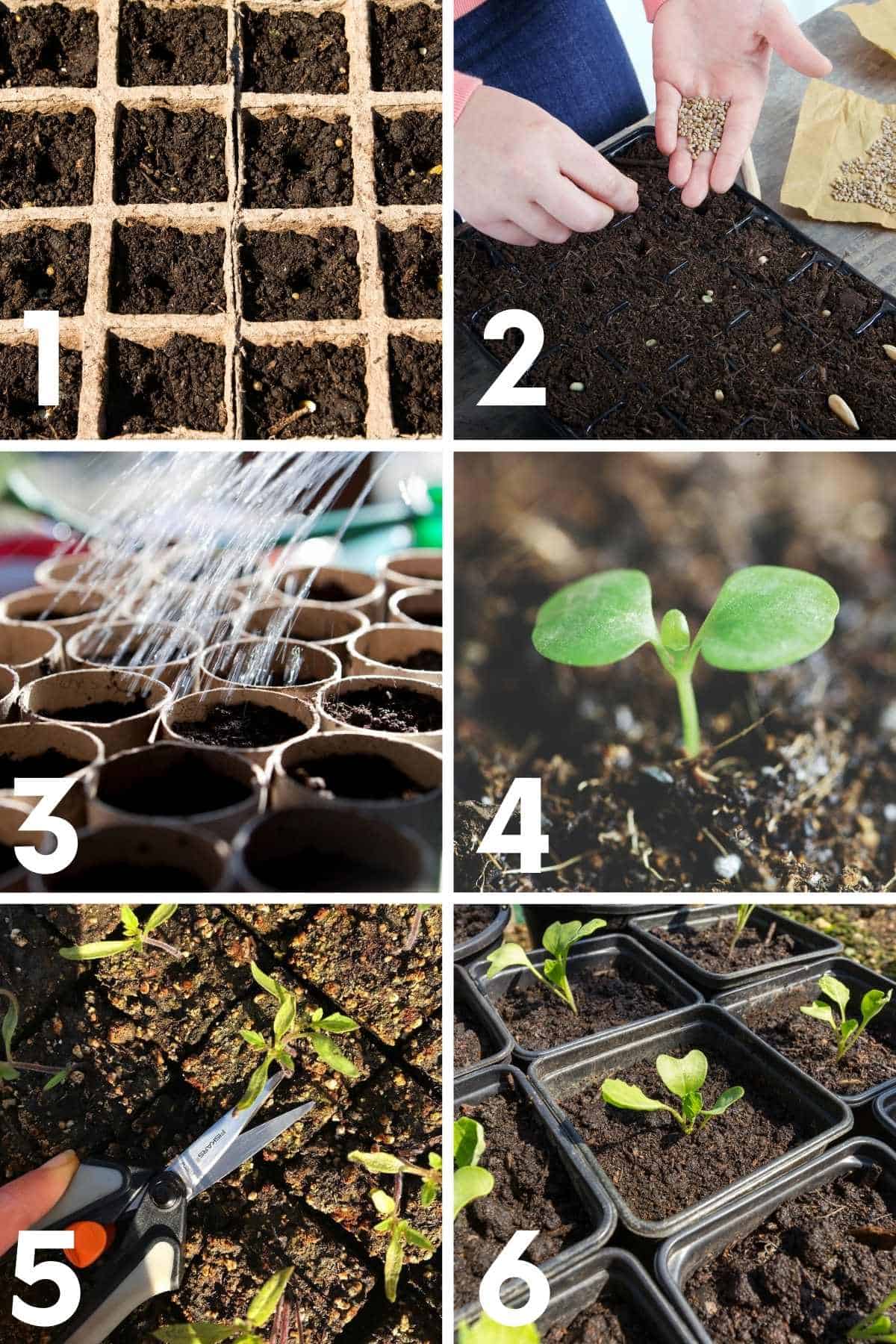
- Fill a pot or cell with a sterile seed starting medium (our favorite mixture is 4 parts coco coir, 2 parts vermiculite, 1 part perlite).
- Sow seeds (2-3) in each spot, about 1/2″ deep in the pot.
- Gently water the seedlings using a mist or sprayer. Keep the soil of the newly planted seeds evenly moist while awaiting germination. The best way to do this is with a spray bottle.
- Place the seeds in an area where the temperature stays between 70-75°F for quickest germination. You should see some seeds popping up within 5-7 days.
- Once seeds have shown their true leaves, clip out any extra seedings in each cell with a small pair of scissors or snips.
- After the plants have 2-4 sets of true leaves, you can pot up the seedlings into larger pots filled with fertile soil (organic potting soil is great for this), so they can really take off!
Growfully Protip
Make sure to keep a fan running on low on your seedlings after they have sprouted. This prevents fungal issues and makes for strong stems.
How do I transplant Brussels sprouts seedlings?
Transplant time is about 10 weeks before your first fall frost in the garden. In many areas, that’s still a very hot time of year, so try to time your Brussels sprout planting for a cooler, cloudier day to prevent transplant shock. Here’s how to get your Brussels sprouts in the garden:
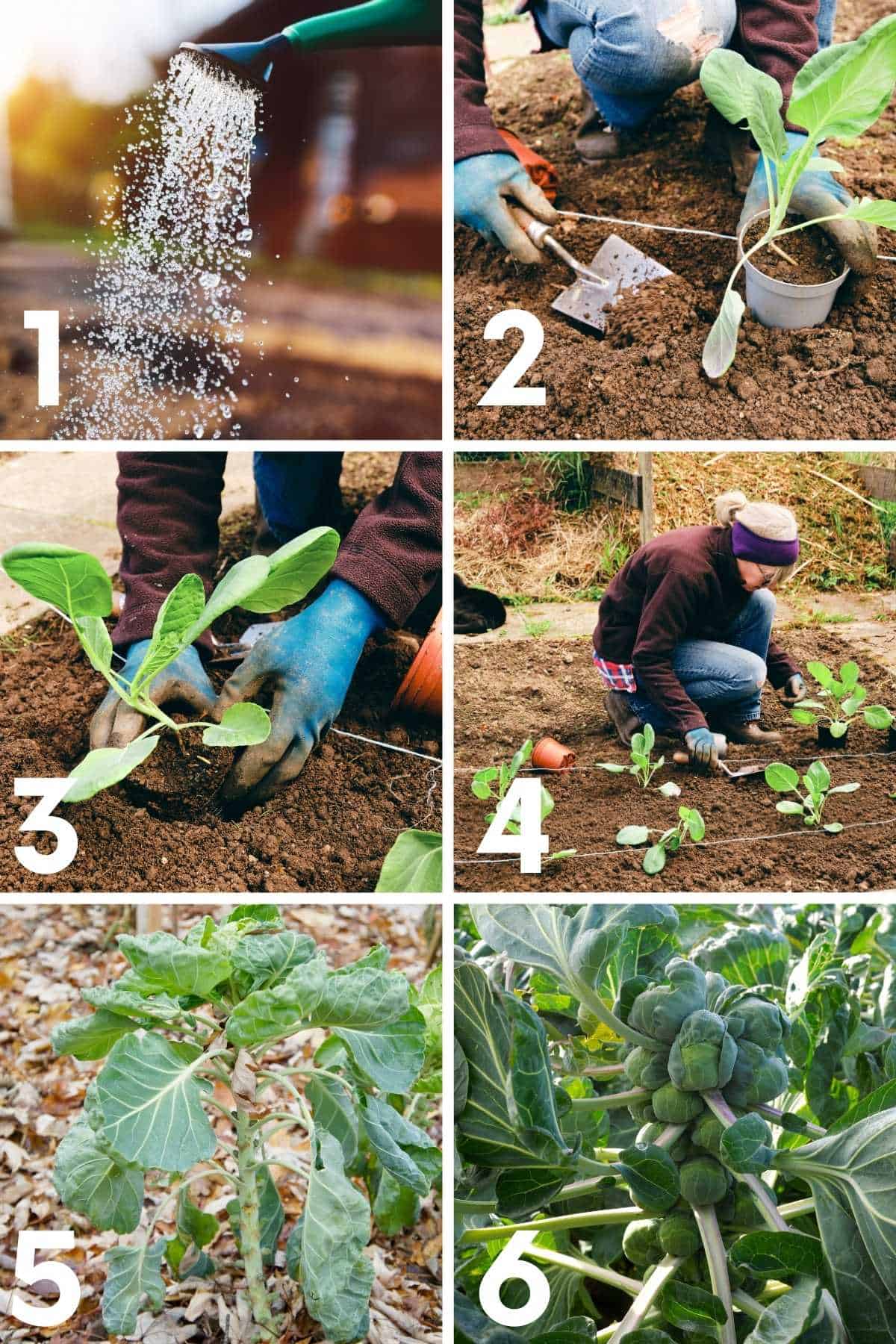
- Water the garden bed and the seedlings well about an hour before you are planning on transplanting. This helps keep everything cool and makes the seedlings easier to work with.
- Dig a hole about 1 1/2 times the size of the Brussels sprout seedling pot. Feel free to amend the hole with compost or a balanced fertilizer.
- Place the seedling in the hole, then backfill with the soil. Use your hands to firm the ground around the seedling to set it in place.
- Give your seedlings a full 18-24″ spacing on all sides when planting your next plant.
- Mulch your seedlings well—this helps with soil moisture retention and soil cooling during the heat of summer.
- When planting in the heat of summer, Brussels sprouts will enjoy some partial shade during the hottest part of the afternoon sun. They still require 4-6 hours of sunlight per day, but some shade cloth or natural shade during the afternoon during the first few weeks in a garden is appreciated.
Growfully Protip
Cabbage moths and cabbage loopers can quickly (and heartbreakingly) fly in and infiltrate your Brussles sprout patch after planting seedlings. They lay eggs, and their larvae (AKA: cabbage worms) can decimate a Brussels sprout plant in a matter of hours. Prevent this by immediately putting up floating row covers with insect netting after planting seedlings. You can also heavily companion plant with strong-smelling herbs and flowers like dill and marigold to help repel common pests.
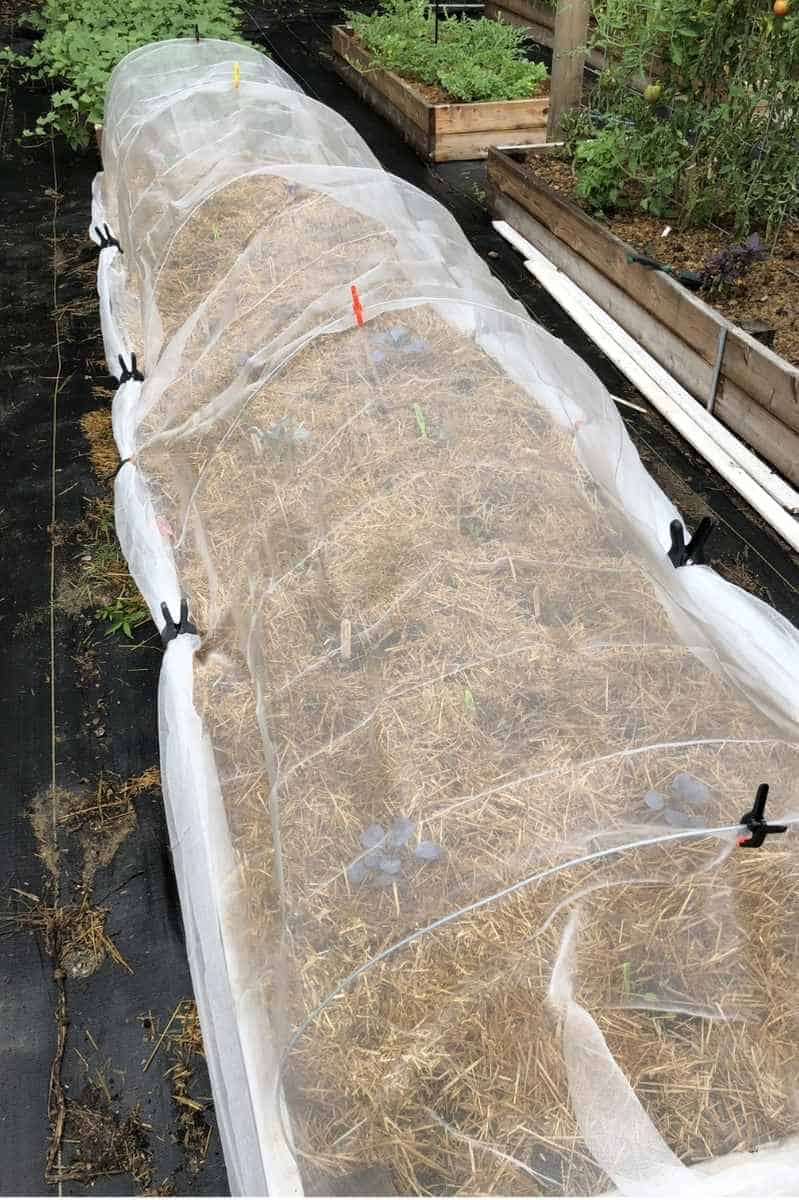
How do I care for the plants?
Download Printable Brussels Sprouts Growing Guide »
Once your Brussels sprouts are in the ground, you’re mostly just playing the waiting game! The plants will grow very slowly during the hot days in late summer, but then once days start consistently hitting in the 70s or below, your Brussels sprouts will take off! Here are a few things you need to keep in mind while they grow:
- Keep your seedlings well mulched to help regulate the soil temperature and reduce weeds—especially during those hot days at the end of summer.
- Brussels sprouts have shallow roots, which sometimes means the plants require staking.
- Cabbage moths and cabbage loopers will find your Brussels sprouts. Prevent this with well-fitting insect netting and/or a heavy planting of moth-repelling companion plants like marigold and dill.
- Brussels sprouts are fairly heavy feeders and will appreciate a regular side-dressing of balanced-fertilizer or compost.
- When you see leaves starting to yellow or die back—don’t worry, this is a natural part of the Brussels sprouts’ growing habitat. Just snap off all leaves that look less than stellar so the plant puts its energy into the sprouts.
- Once the temperatures have dipped down considerably in the fall, and insect activity has dwindled, you can remove any floating insect covers. This also gives the plants more room to grow!
Growfully Protip
You’ll see Brussels sprouts start to form on the stalk about 50 days after sowing.

What can I plant near my Brussels sprouts?
The number one goal for companion planting near Brussels sprouts is to help repel insects like cabbage moths. Strong-scented herbs and flowers will really help here. We interplant our Brussels sprouts with dill and marigold, but other strongly-scented plants like sage, thyme, or tansy will also work.
Do I need to rotate my crop?
You’ll want to make sure to not plant Brussels sprouts after or before any other member of the cabbage family—cabbages, cauliflower, broccoli, kohlrabi, kale, etc.
Growfully Protip
Brussels sprouts enjoy a slightly acidic garden soil with a soil pH of between 6.0 and 6.8. For your best sprouts, make sure to test your pH each season and adjust as needed.
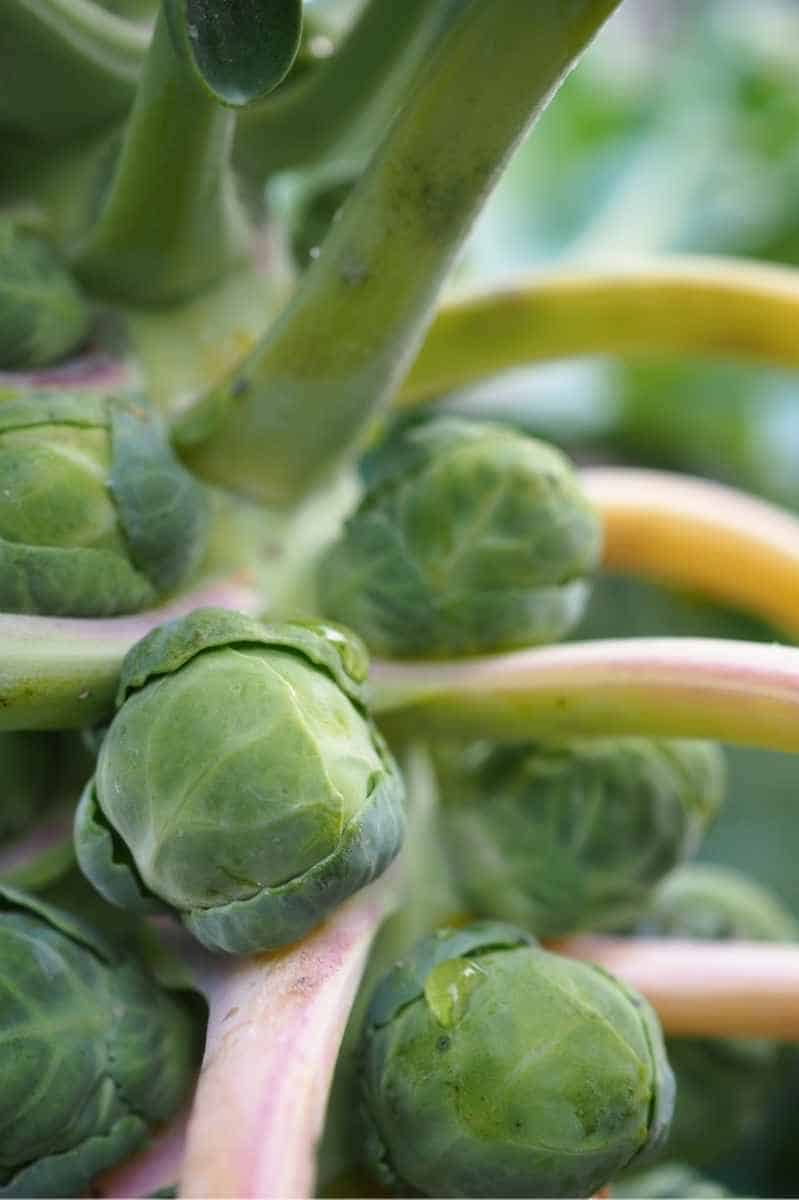
How do you harvest Brussels sprouts?
There are two methods for harvesting Brussels sprouts. You can either keep the plant growing and harvest as you need (my favorite method!) or you can cut off the entire stalk and harvest it at one time. The growing and harvest methods are slightly different between the two.
If you want to harvest sprouts as they become available:
- Once the sprouts are 1 to 2 inches in diameter, it’s time to start harvesting! Start harvesting from the bottom of the stalk up, as these are the oldest sprouts.
- Once you’ve harvested some sprouts, make sure to snap off any leaves surrounding the area you harvested—that allows the plant to put more of its energy into growing more sprouts.
- Keep harvesting all fall and winter long! Except in the very coldest of climates, Brussels sprouts will overwinter in the garden without cover. A layer of frost protection cloth will help Brussels sprouts overwinter even in cold climates.
Growfully Protip
Brussels sprouts are a huge part of our winter garden each year here in zone 6b! We start harvesting on our sprouts in October and don’t stop until well into April. Even in the coldest of years!
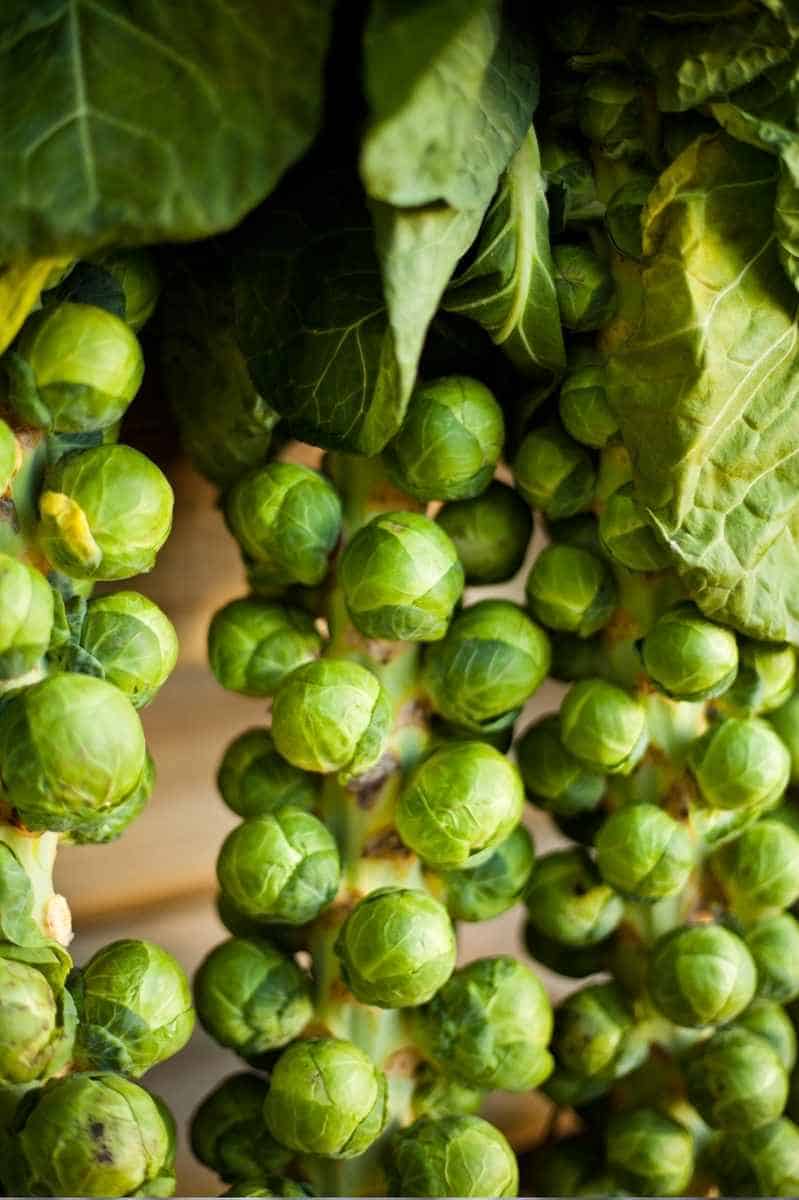
If you want to harvest an entire stalk of Brussels sprouts:
- Harvesting an entire stalk of Brussels sprouts is impressive, but it’s not the way to get the highest production of sprouts. You might want to harvest an entire stalk if you live in an area with very cold winters—this way you can push the Brussels sprouts to fill out an entire stalk and then harvest it and keep in cold storage.
- To promote the growth of an entire stalk, let the plant grow and start setting sprouts until about a month before your first hard freeze of the year.
- A month before your first hard freeze, snap off any leaves on the plant below the top 2-3 rows of leaves, and also clip off the top rosette of the plant. This stops the plant from growing upward and encourages the plant to put all its energy into filling out the sprouts already on the stalk.
- Once your sprouts are large enough, cut off the entire stalk or pull out the entire plant. Keep it in cold storage or under refrigeration for up to a month.
Growfully Protip
Brussels sprouts taste their very best after they’ve been nipped by a heavy frost or two (or even a hard freeze)—so don’t pull your plants until after then! The cold temps bring out the sweetness in the sprouts.
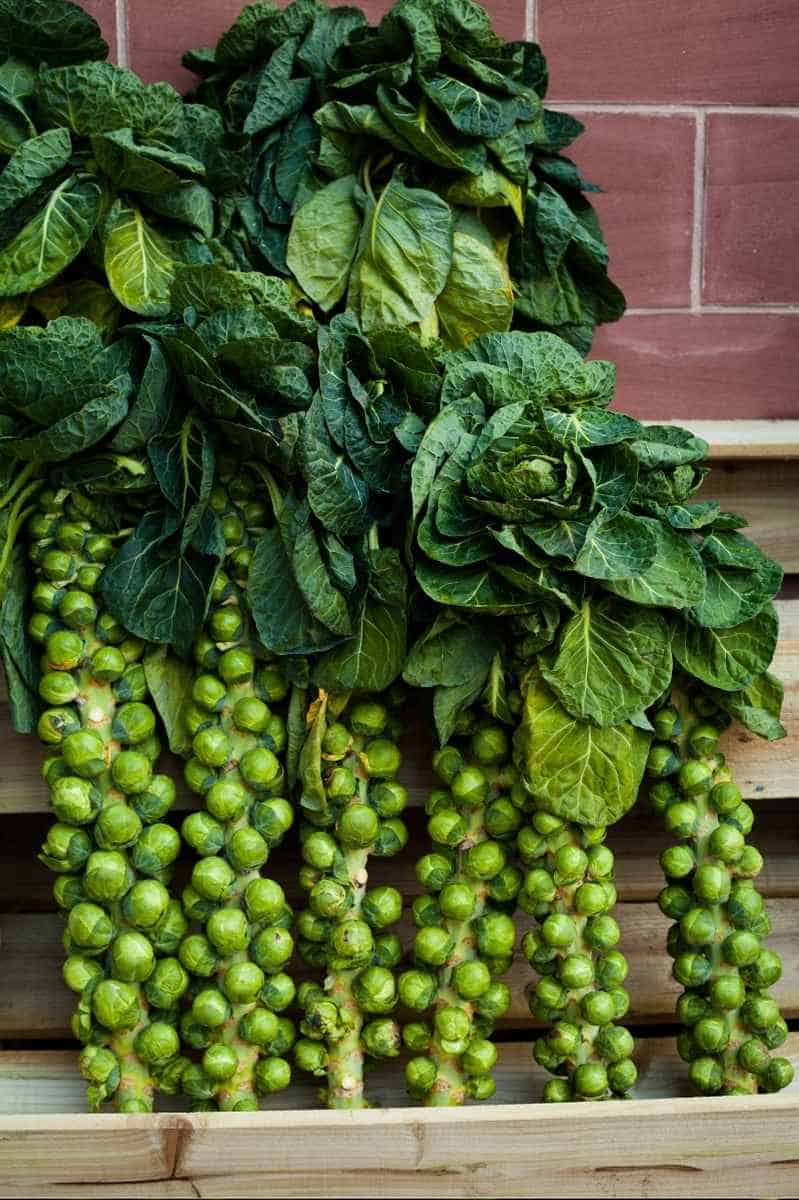
How many Brussels sprouts will one plant produce?
There is no set amount for a single plant to produce—it can vary pretty widely, depending on conditions and variety—but it’s not unusual for a single Brussels sprout plant to produce 3 or more pounds of sprouts in a season. That’s enough for most families of four to have for three meals.
How many times can you harvest Brussels sprouts?
With the single sprout harvesting method, you can keep harvesting sprouts all season long. We’ve been known to harvest each of our Brussels sprout plants 6-8 times during the fall and winter. We just take what we need for dinner, and leave the rest behind to keep growing!
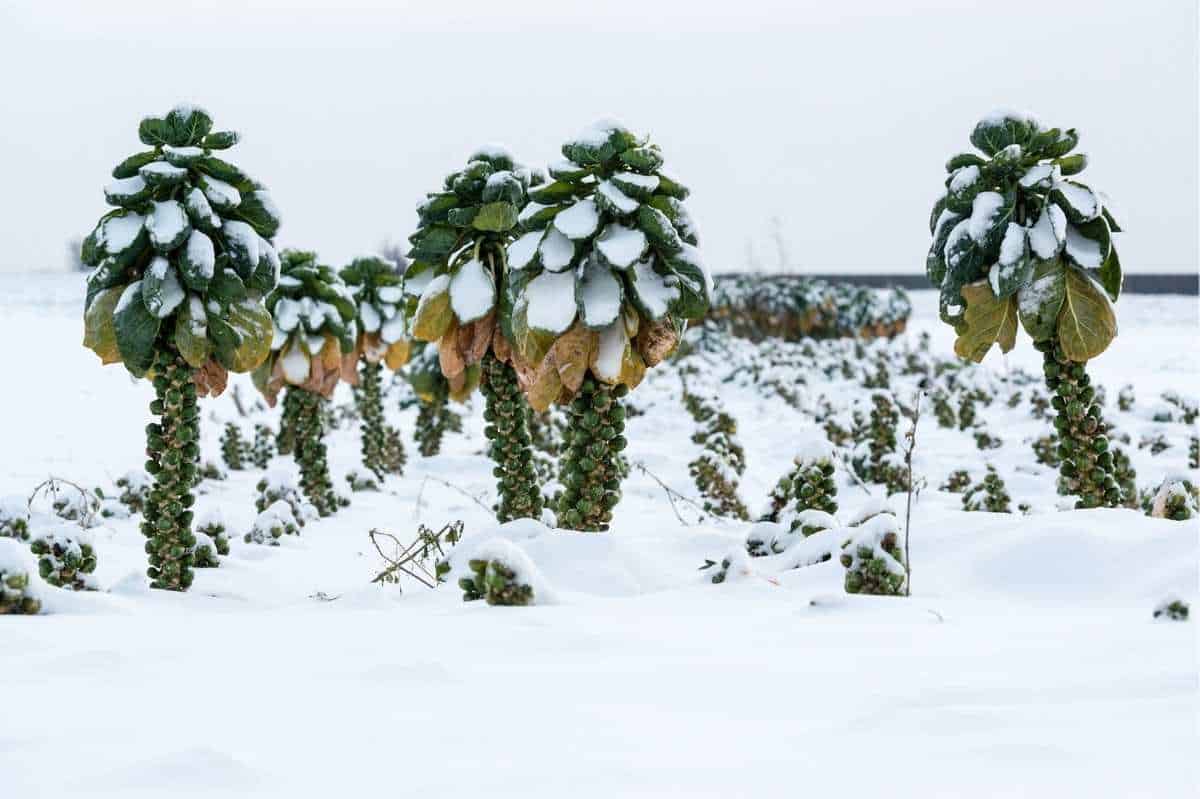
Do Brussels sprouts come back every year?
Brussels sprouts are biennials, meaning their life cycle is two years long—the first year, they produce the plants and sprouts, and in the second, they produce a reduced number of sprouts and go to seed. In cooler, milder climates (like the Pacific Northwest), you can grow Brussels sprouts all year long, but they will require replanting once their life cycle is over. In most growing zones, Brussels sprouts need to be replanted each fall.
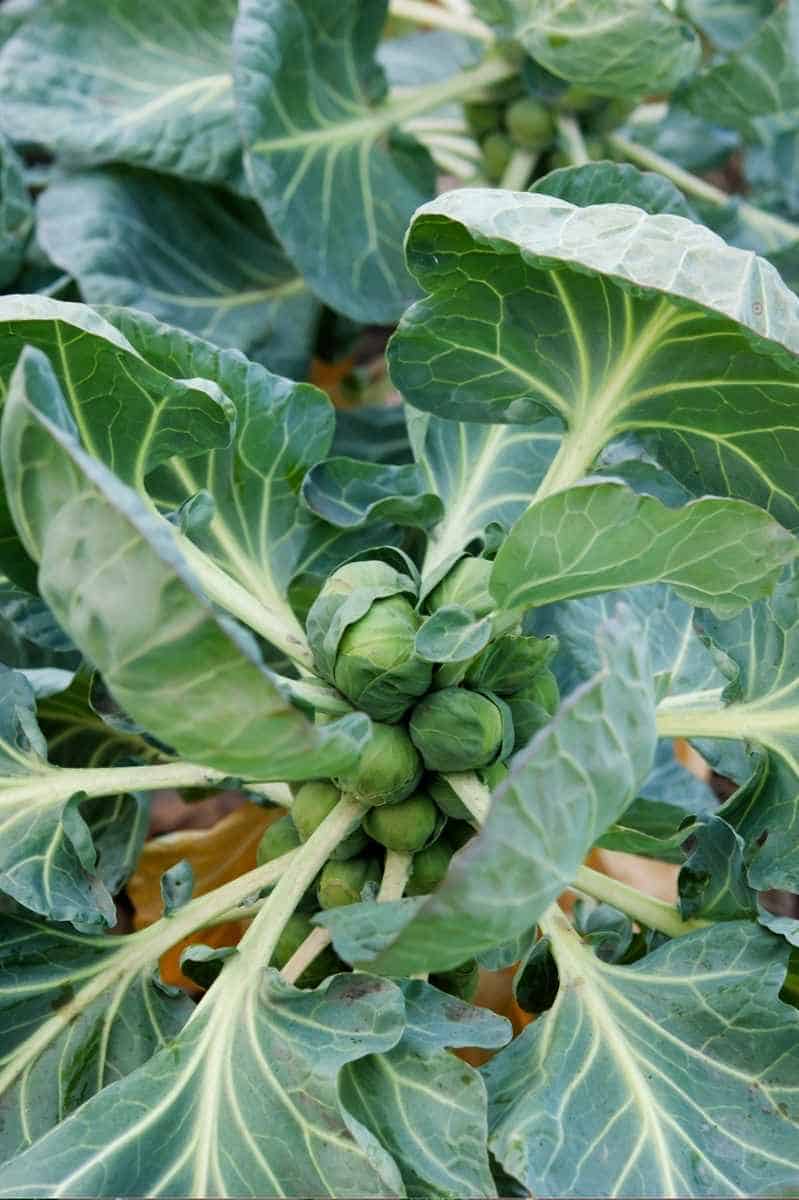
Troubleshooting
Brussels sprouts are plagued by a number of common pests, but the good news is that the vast majority of pest problems can be solved with just a little bit of prevention:
- Floating row covers of light, well-fitting insect netting will go a long way to prevent cabbage worm/cabbage moth and cabbage looper infestations. We do not plant cabbage family plants in the Growfully gardens without insect netting!
- Heavy interplanting of strongly-scented herbs and flowers like dill, marigold, and tansy can help repel butterflies (like cabbage moths) who lay eggs that hatch into plant-destroying caterpillars (like cabbage worms).
- Cutworms occasionally find Brussels sprouts seedlings, and it’s best to just handpick those off if you see them.
- Cabbage aphids have been known to infect plants. Just wash any you see off with a strong hose spray.
- Powdery mildew is occasionally a problem for Brussels sprouts, but because of the timing of seasons, is usually not severe enough to cause any major issues.
- Practicing crop rotation (never planting brassicas after or before other brassicas) can help prevent diseases.
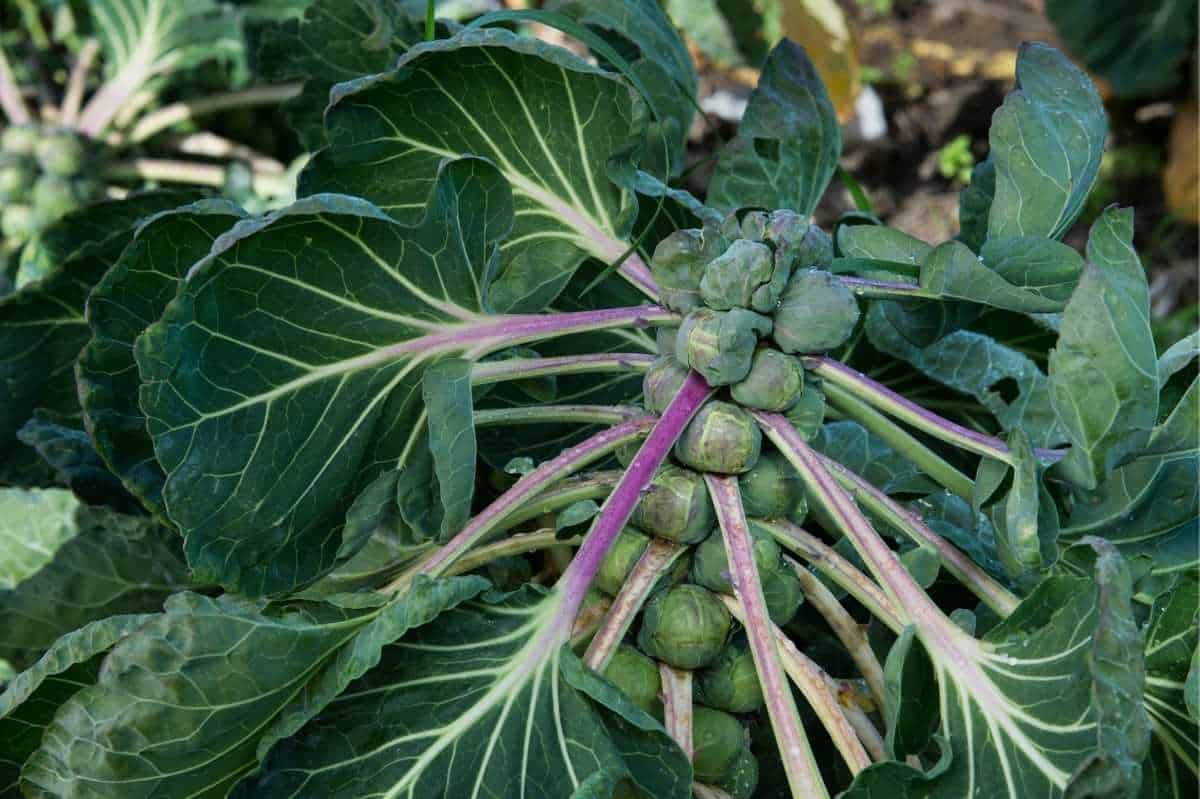
Varieties of Brussels Sprouts:
There are dozens of varieties to try out in the garden, here are some of our favorites:
- Long Island Improved (90 days)—These short-stalked Brussels are one of the first sprouts to mature in the garden. They are typically self-supporting.
- Jade Cross (90 days)— This shorter-season version is a good option for places where the fall season is short.
- Redarling (145 days)—This is our favorite of the purple sprouts as it holds in the winter garden incredibly well!
- Rubine (155 days)—These purple sprouts are a must grow in any garden! This is a show-stopping heirloom that is very fun to grow and harvest!
- Falstaff (102 days)— This is another purple/red sprout whose color intensifies after a frost!
- Diablo (110 days)—This is a very cold-hardy sprout that is good for folks with cold falls and winters.
- Nautic (150 days)—This plant has open spaces between the sprouts, making them very easy to harvest.
- Igor (200 days)—This is our absolute favorite sprout for winter harvesting. Its long growing season means you’ll be harvesting sprouts well into winter!
Growfully Protip
Make sure to grow a combination of early maturing (90 days), midseason (150 days) and long season (200 days) Brussels sprouts to extend your harvest all fall and winter long!
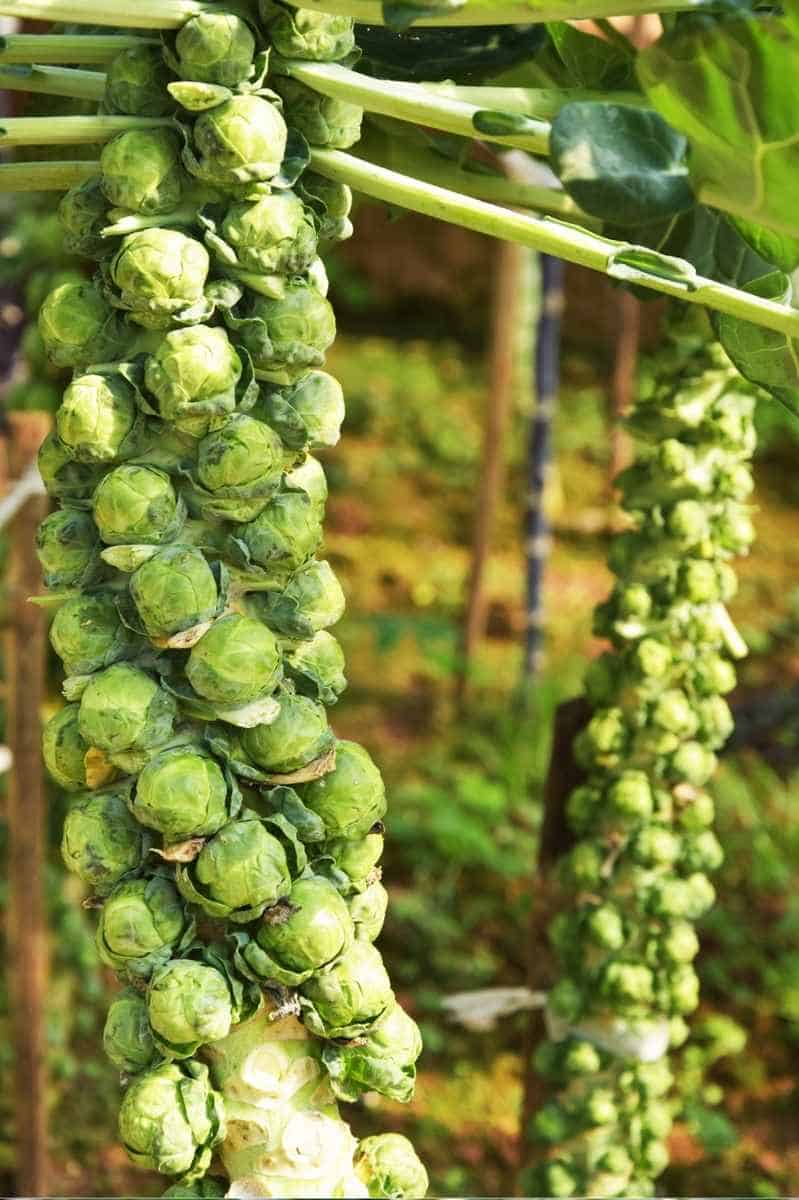
While Brussels sprouts do take up a lot of space in the garden for a long growing season, they also reward you for your patience with pounds and pounds of tender, sweet sprouts! With proper timing, you can be harvesting fresh sprouts from the garden when everything else is brown and crunchy with frost! Happy growing.
Download Printable Brussels Sprouts Growing Guide »
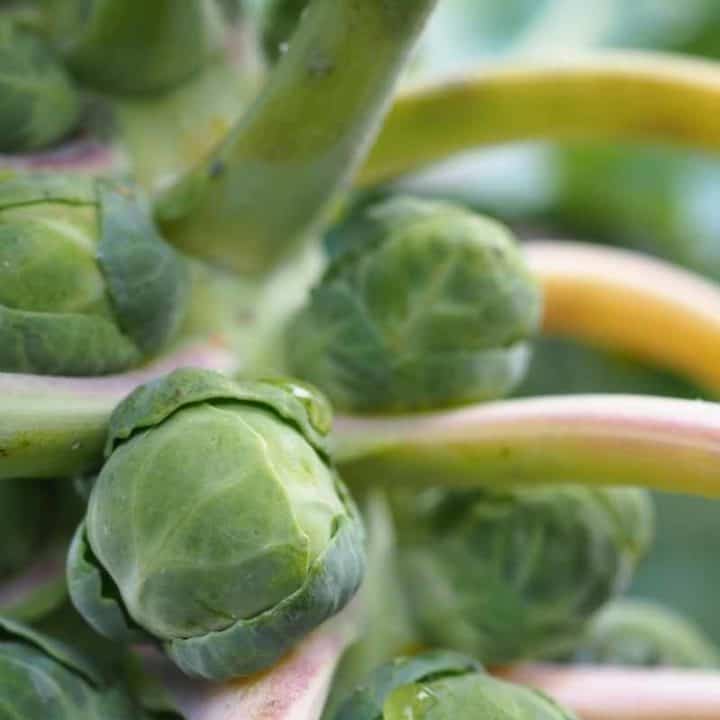
How to Grow Brussels Sprouts
Brussels sprouts are a plant-it-and-forget-it cool-weather vegetable. This article details how to plant and grow sprouts from seed to harvest!
Materials
- Brussels sprouts seeds
Tools
- Organic mulch
- Rich, well draining soil
- Insect netting
- Brussels sprouts growing guide
Instructions

- Plant on a cool day. Avoid transplant shock by moving your seedlings to the soil on a cooler, cloudier day.
- Use plenty of mulch. A good layer of mulch will help keep the soil cool, which Brussels sprouts prefer.
- Feed regularly. Brussels sprouts take a lot of nutrients out of the soil, and do well with a regular side dressing of compost or fertilizer.
- Cover them up. Insect netting during the first few weeks your seedlings are in the soil will keep cabbage moths and cabbage loopers away.
- Lean on companion planting. Strong smelling herbs and flowers, like dill and marigolds, will help repel pests.
- Practice crop rotation. To head off diseases, never plant brassicas like Brussels sprouts before or after other brassicas.

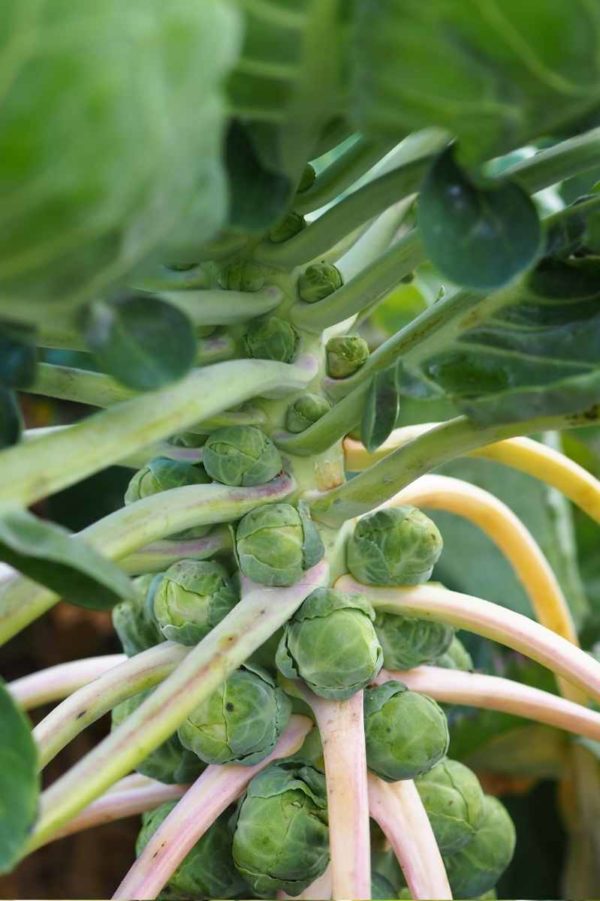






I live in zone 7a, and started some Brussels sprouts from seed indoors. I must have started them too late, because they did not develop “true sets of leaves”, until after the ground was frozen. They are still indoors in their original 3 inch pots and mostly seed starting mix, however they are growing and look healthy. Each plant is about 4- 6″ tall and have 6-12 half inch leaves, and a thin U-shaped stem. They definitely seem too fragile to go outside this time of year. Is there anything I can do to get them to grow indoors?, should I try planting them outside in spring, or repot them and put them out next fall?
You could try putting them in the ground as soon as it’s warm enough to be worked in the spring with some frost protection over them and see what happens. You might have enough growth on them that they take off well and you get sprouts before the heat of summer hits.